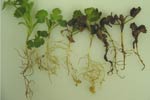Photo Gallery of Vegetable Problems
Coriander/cilantro
(Click on photo to enlarge)
Diseases
Disease: Bacterial leaf spot
Pathogen: The bacterium Pseudomonas syringae pv.
coriandricola. A few other bacterial foliar pathogens of coriander/cilantro have been documented in the Pacific Northwest but are less common, i.e.,
Xanthomonas campestris pv. coriandri and Xanthomonas hortorum pv.
carotae. The parsley bacterial leaf spot pathogen is Pseudomonas syringae pv.
apii.
Host crops: Cilantro/coriander. Based on field research, the cilantro and parsley bacterial leaf spot problems are caused by two pathogens:
Pseudomonas syringae pv. apii and P. syringae pv. coriandricola.
Pseudomonas syringae pv. apii is also the causal agent of bacterial leaf spot diseases of celery and fennel. However, these cilantro and parsley pathogens can infect other crops in the Apiaceae, so plan crop rotation with the possibility of cross infection among cilantro, parsley, celery, and fennel.
 |
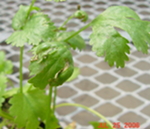 |
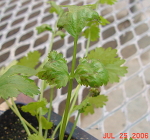 |
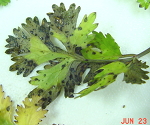 |
| Symptoms of bacterial leaf spot on cilantro/coriander caused by Pseudomonas syringae pv. coriandricola |
|||
| Photo Source: Lindsey du Toit, Washington State University | |||
Online Resources:
Coriander and Cilantro (Coriandrum sativum)-Bacterial Leaf Spot, PNW Plant Disease Management Handbook
Bacterial Leaf Spot, Cilantro and Parsley Pest Management Guidelines, UC Iintegrated Pest Management Program
Disease: Curly top
Pathogen: Various strains of Beet curly top virus (BCTV), which are vectored by the beet leafhopper (Circulifer tenellus)
Host crops: Numerous plant species including many vegetables such as bean, beet, carrot, eggplant, coriander, pepper, potato, tomato, various cucurbits such as squash, cucumber, pumpkin, watermelon, etc.
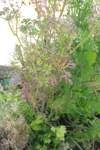 |
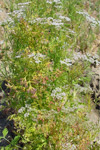 |
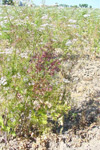 |
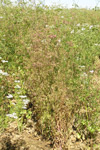 |
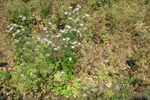 |
| Symptoms of curly top in a coriander seed crop including stunting, purpling/yellowing of the foliage, and death of plants. |
||||
| Photo Source: Lindsey du Toit, Washington State University Plant Pathologist | ||||
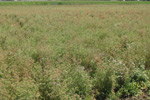 |
| Symptoms of curly top in a coriander seed crop including stunting, purpling/yellowing of the foliage, and death of plants. |
| Photo Source: Lindsey du Toit, Washington State University |
On-Line Resources:
Pacific Northwest Plant Disease Management Handbook: Bean, All (Phaseolus vulgaris) – Curly Top
Nematodes
Disease: Root knot
Nematode: Meloidogyne species
Host crops: Numerous plant species, including many vegetables such as carrot, coriander, onion, potato, etc.
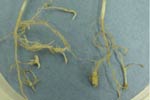 |
| Swollen, galled roots of coriander plants caused by the root knot nematode. |
| Photo Source: Lindsey du Toit, Washington State University |
On-Line Resources:
Pacific Northwest Plant Disease Management Handbook: Carrot (Daucus carota) – Nematode, Root-knot
Pacific Northwest Plant Disease Management Handbook: Nematodes
Cilantro Production in California. Vegetable Production Series, UC Vegetable Research & Information Center
See Diseases, pests, and other problems common to many vegetables: Root knot
Our pages provide links to external sites for the convenience of users. WSU Extension does not manage these external sites, nor does Extension review, control, or take responsibility for the content of these sites. These external sites do not implicitly or explicitly represent official positions and policies of WSU Extension.



